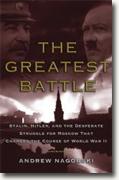The Greatest Battle
Andrew Nagorski
book reviews:
· general fiction
· chick lit/romance
· sci-fi/fantasy
· graphic novels
· nonfiction
· audio books
· author interviews
· children's books @
curledupkids.com
· DVD reviews @
curledupdvd.com
newsletter
win books
buy online
links
home
for authors
& publishers
for reviewers

 |
The Greatest Battle: Stalin, Hitler, and the Desperate Struggle for Moscow That Changed the Course of World War II Andrew Nagorski Simon & Schuster Hardcover 384 pages September 2007 |
|
The Eastern Front in World War II is known for many things: the heroic stand of the Soviet troops at Stalingrad, the massive tank battle at Kursk, the three-year siege of Leningrad that resulted in mass starvation of the populace. While itís common knowledge that Hitlerís invasion of the Soviet Union in 1941 faltered just short of Moscow due to the extreme winter weather, for which the Germans were unprepared because Hitler insisted the war would be won before it set in, not much has been chronicled about the actual battle for the Soviet capital.
As with most history books, Nagorski starts out by setting the stage, discussing the German-Soviet pact signed in 1939 that allowed the two powers to divide Poland between themselves, as well as allowing the Soviets to expand farther into Eastern Europe. Nagorski uses these opening chapters to also showcase how both paranoid and naive Stalin was regarding Hitler and the German war machine. He seemed desperate to maintain the peace, even going so far as to discredit any of his spies who tried to tell him that the Germans were beginning to mass on the border in preparation for an attack. Stalin seemed paralyzed when Hitler first crossed the frontier, unable to believe that the Germans were doing anything more than war exercises, and unwilling to allow his troops to fight back in those first crucial hours. This resulted in the loss of many hundreds of thousands of troops. Nagorski does an excellent job analyzing the conduct and thought processes of both leaders, highlighting mistake after mistake that enable first Hitler, then Stalin, to gain the upper hand in the ongoing battle. Hitlerís decision to delay the final assault on Moscow for over a month is shown to be a fatal blunder, one that his top Panzer general, Guderian, credits for beginning the loss of the war. I especially enjoyed reading about the dictatorsí relationships with their generals, and how they refused to hear what they didnít want to believe. Nagorski provides details of the bitter conditions for the German army once the winter set in, and how Hitler and Goebbels refused to believe that the army could really be suffering that much. Whatís especially riveting about The Greatest Battle Nagorski pulls no punches in his analysis of the entire battle. He demonstrates the Soviet disregard for the humanity of its soldiers, thrown them into the meat grinder of battle in mass human wave attacks, guaranteed to cause massive casualties. NKVD (forerunners of the KGB) battalions followed military units into battle to make sure there were no thoughts of desertion. Stalin has a general executed and then, when the generalís brother comes to speak with him, acts like heís never heard of the general. These details bring The Greatest Battle Despite how good this book is, however, there are some problems with it. First, Nagorski spends much more time discussing the overarching aspects of the battle and how it affected the civilian population than he does the actual military situation. There are a couple of maps detailing the invasion and the assault on Moscow, as well as the counter-productive Soviet counterassaults in the early months of 1942, and there are some descriptions of battles in the book. Overall, though, The Greatest Battle Secondly, there are some pacing problems, or at least decisions that I disagree with. He ends one chapter on a seeming cliffhanger, mentioning that Moscow was literally in a panic. Nagorskiís next chapter is a fairly long discussion (30 pages) of how the rest of the world reacted to the possibility that Moscow might fall, going back in time to where Franklin Roosevelt decided to establish diplomatic relations with the Soviet government in the 1930s and then moving forward. This is an interesting chapter, but he doesnít get back to his panicked Moscow citizens until the following chapter. This could be fine in a novel, where suspense is something you want, but in a history book? For me, it just ruptured the narrative flow. Finally, The Greatest Battle While these problems do detract from the book, itís still extremely interesting. I love the fact that so much of Nagorskiís information comes from interviews with survivors of that battle so many years ago. It immerses the reader in the history, making it even more vivid. Nagorskiís writing style also keeps you reading, not getting bogged down in extraneous historical detail. The Greatest Battle Originally published on Curled Up With A Good Book at www.curledup.com. © Dave Roy, 2008 |
|
|
|
 Click here to learn more about this month's sponsor! |
|
| fiction · sf/f · comic books · nonfiction · audio newsletter · free book contest · buy books online review index · links · · authors & publishers reviewers |
|
| site by ELBO Computing Resources, Inc. | |
 That is, until now. Andrew Nagorskiís
That is, until now. Andrew Nagorskiís